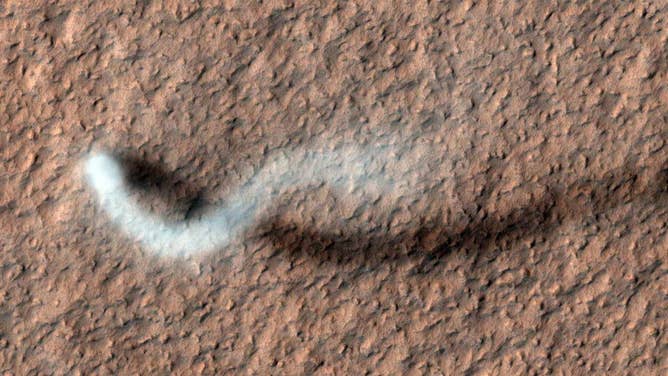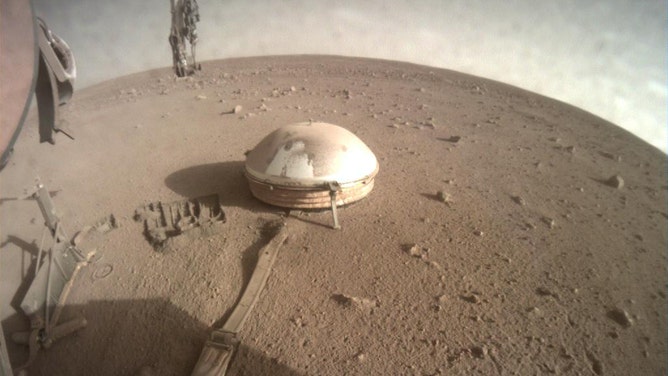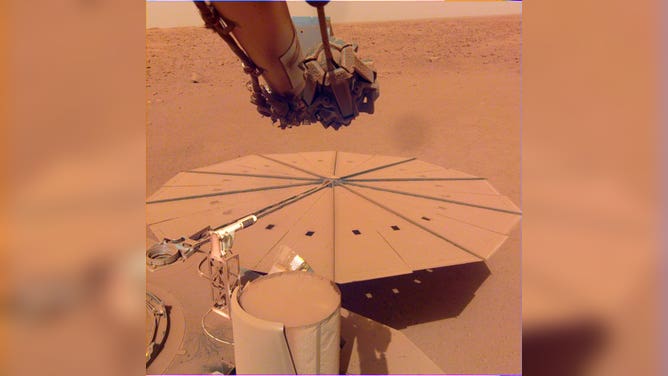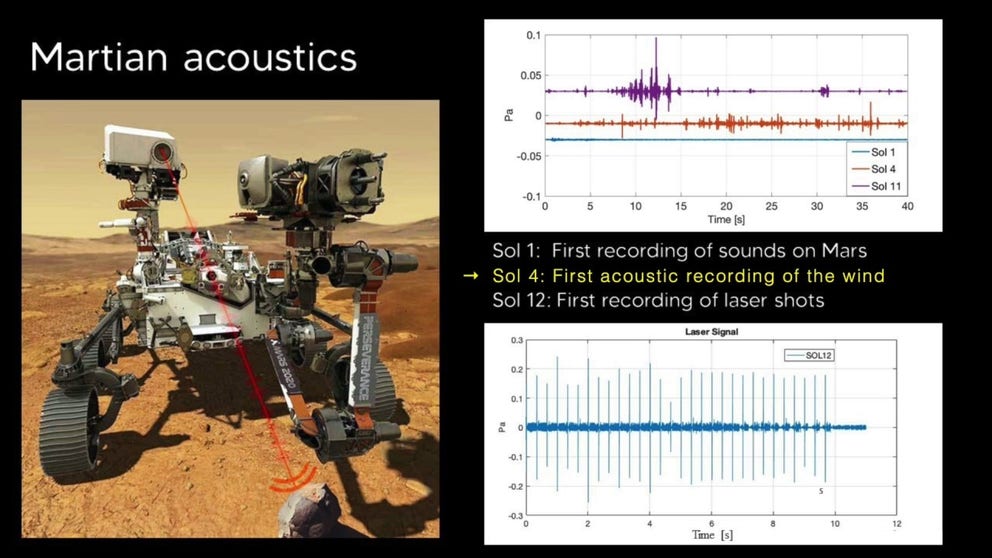'Continent-size' dust storm takes out NASA's seismic station on Mars
As the battery continued to deteriorate, mission scientists were forced to turn off InSight's seismometer for the next two weeks. NASA's InSight Mars lander's primary mission is to listen to the pulse of Mars using a seismometer and study the planet's deep interior.
NASA's InSight Mars lander captures sound of meteorite hitting planet
NASA's InSight Mars lander captured seismic waves from several meteoroids impacting miles away.
A "continent-size" dust storm is eroding NASA's only active seismic station beyond Earth.
NASA says its Mars InSight lander mission recorded a recent drop in power generated as the storm swirls over Mars' southern hemisphere.
The dust storm was first observed on Sept. 21, and space officials say that by last week, the storm had grown large enough to increase dust by nearly 40% in the Martian atmosphere.
With the hazy atmosphere obstructing light to the lander's solar panels, NASA's InSight Mars lander's energy fell from 425 watt-hours per Martian day, or sol, to just 275 watt-hours per sol.

NASA's Mars InSight lander starts to slowly shut down after dust storm takes diminishes its power.
(NASA InSight / FOX Weather)
The battery continued to deteriorate, and mission scientists were forced to turn off InSight's seismometer for the next two weeks.
"We were at about the bottom rung of our ladder when it comes to power. Now we're on the ground floor," said InSight's project manager, Chuck Scott of NASA's Jet Propulsion Laboratory. "If we can ride this out, we can keep operating into winter – but I'd worry about the next storm that comes along."
'THE BIG ONE': MONSTER QUAKE ON MARS TO PROVIDE VIEW INTO PLANET LIKE NO OTHER
InSight, which stands for Interior Exploration using Seismic Investigations, Geodesy and Heat Transport, landed on Mars in 2018 with the primary mission of listening to the pulse of Mars using a seismometer and studying the planet's deep interior.
The lander's mission was originally extended until the end of the year, but due to the storm, it is unlikely to continue operations through the extension.
Scientists say the lander has long since surpassed its primary mission and is conducting "bonus science" missions by measuring marsquakes through its extension.
More about Martian storms

This series of images from a navigation camera aboard NASA’s Perseverance rover shows a gust of wind sweeping dust across the Martian plain beyond the rover’s tracks on June 18, 2021
(NASA/JPL-Caltech)
The dust storm affecting the InSight lander is the third storm of its kind observed this year.
Scientists say that the storm's growth is slowing and reaching its decay phase.
"The dust-raising clouds observed in pictures from the orbiter's Mars Color Imager camera, which creates daily global maps of the Red Planet and was the first instrument to spot the storm, are not expanding as rapidly as before," NASA said.
LISTEN: NASA Perseverance rover records wind on Mars
This recording was made on Feb. 22, 2021, by the SuperCam instrument on NASA’s Perseverance rover after deployment of the rover’s mast. Some wind can be heard, especially around 20 seconds into the recording. (Image Credit: NASA/JPL-Caltech/LANL/CNES/CNRS/ISAE-Supaero)
Most storms of this size happen during fall and winter. Winds can reach up to 60 mph and toss dust high into the atmosphere, which takes weeks to come down.
FATE OF SEISMIC AND WEATHER MONITORING ON MARS DEPENDS ON A DUST DEVIL
"On rare occasions, scientists have seen dust storms grow into planet-encircling dust events, which cover almost all of Mars," NASA said. "One of these planet-size dust storms brought NASA's solar-powered Opportunity rover to an end in 2018."
In May, NASA hoped for a storm of a much smaller magnitude to help the InSight mission.

A towering dust devil casts a serpentine shadow over the Martian surface in this image from NASA Mars Reconnaissance Orbiter.
(NASA/JPL-Caltech/Univ. of Arizona)
As scientists prepared retirement plans for the InSight mission, they said the only thing that could prevent its end was a dust devil. If just 25% of the lander's panels were swept clean by a dust devil, the lander would gain about 1,000 watt-hours per day – enough to continue collecting science.
WITNESSING DUST DEVILS: NASA’S ROVER BRINGS NEW MEANING TO MARTIAN DUST STORMS
About NASA's InSight Lander

(NASA/JPL-Caltech)
InSight, the Interior Exploration using Seismic Investigations, Geodesy and Heat Transport, landed on Mars on Nov. 26, 2018.
The mission's seismic monitoring of marsquakes has provided constraints on Mars' interior, formation, and current activity.
Its pair of 7-foot solar panels produce 5,000 watt-hours each Martian day. NASA says this is equivalent to powering an elective oven for an hour and 40 minutes. It has since dwindled to 500 watt-hours per day.

InSight's Dusty Solar Panel: InSight captured this image of one of its dust-covered solar panels on April 24, 2022, the 1,211th Martian day, or sol, of the mission. (Credits: NASA/JPL-Caltech)
InSight has operated the only active seismic station beyond Earth. Information gathered from the quakes has allowed scientists to measure the depth and composition of Mars' crust, mantle, and core.
Its mission was recently extended through the end of the year with hopes to continue its seismic and weather monitoring.

